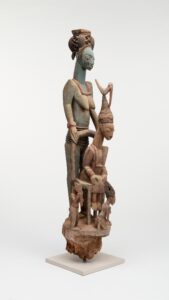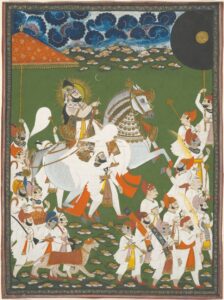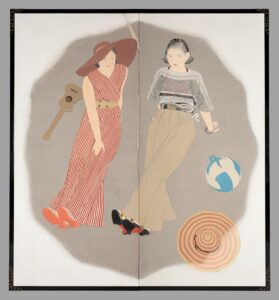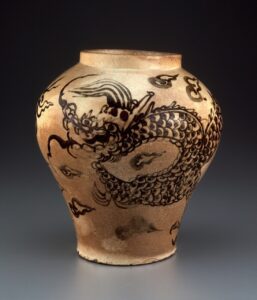Cultural Significance in Art – Analyzing Iconic Works from Diverse Traditions
Title: Veranda Post (Òpó Ògògá)
Artist: Olowe of Ise
Date: 1910-14
Geography: Ikere, Nigeria: Coastal West Africa
Culture: Yòrùbá: Èkìti
Medium: Wood and pigment
Dimensions: 152.5 × 31.75 × 40.6 cm (60 × 12 1/2 × 16 in.)
This piece of art is titled the ‘Veranda Post,’ and it is also known as Òpó Ògògá. This piece of art was carved between 1910 and 1914 by Olowe of Ise. The purpose of its creation was for use as a post for the palace of the Ikere king (Ògògá), to be placed in the palace’s inner courtyard. The Veranda Post (Òpó Ògògá) is a wood carving sculpture of the king, his senior wife, a woman kneeling in front of the king, in some cases presumed to either be his junior wife or a member of the Yoruba community and a man playing the flute to the king’s left side, presumably to announce the arrival of the king. These carvings are all of the different sizes as intended by the carver, Olowe of Ise.
Petridis, Constantine et al. Speaking Of Objects. 2020, pp. 97-98.
In the book Petridis, Constantine et al. elaborate on the carver and the carving. The details of the carving are also elaborated on in the book (p 97). Consistently the carving represents the king (Ògògá) and his queen (Olori), representing the culture of the Yoruba people. This carving represents the king and queen preparing to receive guests or preparing for a Yoruba ceremony (p 97). According to Petridis et al., this piece was one of four, each used as a post, while this sculpture was at the centre of the other three as indicated in a photo by William Buller Fagg, a British Museum curator in 1959 (97). Accordingly, this carving can illustrate the significance of authority and kingdom amongst the Yoruba people, with the portrayal of the king and queen in the art piece. An outstanding aspect of the carving is the posture of all carvings on the piece, including the woman kneeling before the king, indicating the authority bestowed upon the king by the Yoruba people, and the towering senior wife over the king; this would represent the king’s reliance on the queen on various aspects, one of which may be placing the crown on the king’s head. The state of the heads and hats are also emphasized in the piece to indicate the culture of the Yoruba people.
Title: Maharana Bhim Singh in Procession
Artist: Ghasi
Date: 1815–1825
Geography: India
Culture: Indian
Medium: Opaque watercolour and gold on paper
Dimensions: Image: 57.1 × 41.6 cm (22 1/2 × 16 3/8 in.); Paper: 60.7 × 45.6 cm (23 7/8 × 18 in.)
This piece of art is a painting titled Maharana Bhim Singh in Procession dated 1820. The painting is by Ghasi, a Udaipur artist, on an opaque watercolour, silver, and gold on a paper medium. Ghasi’s style is depicted in the painting based on the use of gold, people’s skin tones in the painting, and the outlining in the piece, which is heavy. As a Udaipur artist, Ghasi’s role was painting the princes to fulfil the cultures of the court. Maharana Bhim Singh ruled between 1778 and 1828; thus, the painting is attributed to Ghasi.
Khera, Dipti Sudhir. “Picturing India’s “Land Of Kings” Between The Mughal And British Empires: Topographical Imaginings Of Udaipur And Its Environs.” 2013, pp. 178-180., https://academiccommons.columbia.edu/doi/10.7916/D8DV1S3M.
In this dissertation, Khera elaborates on the painting styles of Ghasi and the practices of Udaipur artists (p 178). Additionally, the significance of topography is also established by Khera (p 180). Accordingly, from the description by Khera, painting analysis is simplified based on the ruler and his surroundings; it is possible to identify the culture of the people of the Mewar Kingdom and their religion. In the painting, Maharana Bhim Singh’s face is painted clearly in the presence of his surroundings. The ruler Maharana Bhim Singh is painted riding a horse with the rein in his hand. The accessory the ruler possesses is also apparent in the painting, especially with the use of gold to outline the jewellery pieces. Surrounding the king are men on foot, a cheetah, and a falcon on leash; it is significant to note that all the animals in the painting also possess jewellery pieces. All aspects of this painting elaborate on the authority Maharana Bhim Singh possessed. From the people’s skin tones and dressing codes and embellishment of all people and animals of the painting, the culture of the people is elaborated, and the climatic conditions can be hinted at based on the skin tones. The landscape of the kingdom is illustrated in the painting to point out the domains of the ruler.
Title: Relaxing in the Shade
Artist: Yamakawa Shûhô
Date: 1928–1938
Geography: Japan
Culture: Japanese
Medium: Two-panel screen; ink and colour on silk
Dimensions: 188.5 × 173 cm
This art piece is titled Relaxing in the Shade, and it is dated 1933. It was created by Yamakawa Shûhô on a Two-panel screen, using ink and colour on silk. In this piece, two modern women with contrasting attires are depicted under a shade by the beach. The Shade, in grey, appears in the shape of an umbrella, indicating that the two women are under an umbrella not represented in the piece other than its shadow. The use of varying colours is, therefore, significant in creating a vivid scenario. The outfits, hats, shoes, and accessories have contrasting colours. Additionally, the women’s hair contributes to their differences, whereby the one on the left covers her hair with a hat, while the one on the left exposes her short hair while placing her hat beside her.
Geist, Kathe. “Seeking A Japanese Modernity: Ozu And Nihonga Painters In The Pre-War Era.” Journal Of Japanese And Korean Cinema, vol 2, no. 2, 2011, pp. 97-108. Informa U, K Limited, https://doi.org/10.1386/jjkc.2.2.97_1
In this article, Geist elaborates on the art piece. Geist analyzes the attires of the two modern women and points out the differences between the two (p 101). the woman on the left has her hat on with brightly coloured clothes on, with a guitar beside her. In contrast, the woman on the right has her hat beside her while wearing dull-coloured clothes; a ball-shaped bag also lies beside her. The different coloured shoes also contribute to the differences between the two women (p 101). Therefore, this article is an essential contrast between the women in the Two-panel screen by Yamakawa Shûhô, while pointing to the modern era before the world war broke out.
Title: Jar with Dragon Chasing Flaming Pearl
Artist: Joseon dynasty
Date: 1601–1700
Geography: Korea
Culture: Korean; Joseon era
Medium: Stoneware painted in underglaze iron brown
Dimensions: H. 31.9 cm; diam. 28.2 cm
The title of this art piece is Jar with Dragon Chasing Flaming Pearl, dated 1601–1700. The art piece is attributed to the Joseon dynasty, and it is a painting on stoneware, a major practice of the Joseon period. The stoneware jar is painted iron brown, and on the jar, a dragon is painted in motion. The simplicity of the piece illustrates the Confucian period ideologies. The dragon painted illustrates the people’s culture, who held dragons in high esteem have symbolic meanings for the people. Therefore, the art piece holds significant meaning for the people of that era.
Lotis, Christopher, and Michel D. Lee. “Symbols Of Identity Korean Ceramics From The Collection Of Chester And Wanda Chang.” 2010, pp. 62 – 128
In this article, Lotis and Lee elaborate on the evolution of artistic style during the Joseon period towards modern times. They further illustrate the significance of the Joseon era culture in modern Korea (p 62). Understanding the culture, the value of symbolism and the practices of people during the Joseon dynasty will enable the analysis of the Jar with Dragon Chasing Flaming Pearl. This analysis will be promoted by the elaboration on the importance of simplicity and symbolism, as the piece represents. Simplicity is elaborated in the condition of the jar and the paintings on the jar; it is important to note that multiple colours are not used on the jar. Symbolism is illustrated in the dragon painting, and as emphasized by Lotis and Lee, symbolism was a vital aspect of the culture during the Joseon dynasty.
Works Cited
Geist, Kathe. “Seeking A Japanese Modernity: Ozu And Nihonga Painters In The Pre-War Era.” Journal Of Japanese And Korean Cinema, vol 2, no. 2, 2011, pp. 97-108. Informa UK Limited, https://doi.org/10.1386/jjkc.2.2.97_1. Accessed 16 Dec 2021.
Khera, Dipti Sudhir. “Picturing India’s “Land Of Kings” Between The Mughal And British Empires: Topographical Imaginings Of Udaipur And Its Environs.” 2013, pp. 178-180., https://academiccommons.columbia.edu/doi/10.7916/D8DV1S3M. Accessed 16 Dec 2021.
Lotis, Christopher, and Michel D. Lee. Symbols Of Identity Korean Ceramics From The Collection Of Chester And Wanda Chang. 2010, pp. 62 – 128
Petridis, Constantine et al. Speaking Of Objects. 2020, pp. 97-98
The Art Institute of Chicago. The Art Institute Of Chicago. The Art Institute Of Chicago, https://www.artic.edu/artworks/
ORDER A PLAGIARISM-FREE PAPER HERE
We’ll write everything from scratch
Question
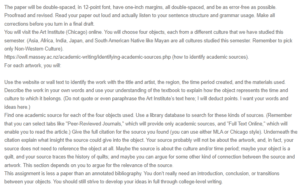
Veranda Post by Olowe of Ise
The paper will be double-spaced, in 12-point font, have one-inch margins, all double-spaced, and be as error-free as possible. Proofread and revised. Read your paper out loud and actually listen to your sentence structure and grammar usage. Make all corrections before you turn in a final draft.
You will visit the Art Institute (Chicago) online. You will choose four objects, each from a different culture that we have studied this semester. (Asia, Africa, India, Japan, and South American Native like Mayan are all cultures studied this semester. Remember to pick only Non-Western Culture).
https://owll.massey.ac.nz/academic-writing/identifying-academic-sources.php (how to identify academic sources).
For each artwork, you will:
Use the website or wall text to identify the work with the title and artist, the region, the time period created, and the materials used.
Describe the work in your own words and use your understanding of the textbook to explain how the object represents the time and culture to which it belongs. (Do not quote or even paraphrase the Art Institute’s text here; I will deduct points. I want your words and ideas here.)
Find one academic source for each of the four objects used. Use a library database to search for these kinds of sources. (Remember that you can select tabs like “Peer-Reviewed Journals,” which will provide only academic sources, and “Full Text Online,” which will enable you to read the article.) Give the full citation for the source you found (you can use either MLA or Chicago style). Underneath the citation explain what insight the source could give into the object. Your source probably will not be about the artwork, and, in fact, your source does not need to reference the object at all. Maybe the source is about the culture and/or time period; maybe your object is a quilt, and your source traces the history of quilts; and maybe you can argue for some other kind of connection between the source and artwork. This section depends on you to argue for the relevance of the source.
This assignment is less a paper than an annotated bibliography. You don’t really need an introduction, conclusion, or transitions between your objects. You should still strive to develop your ideas in full through college-level writing.

